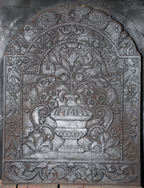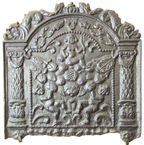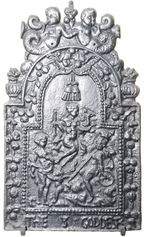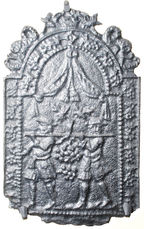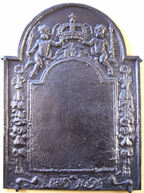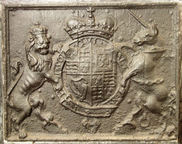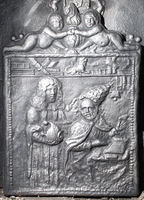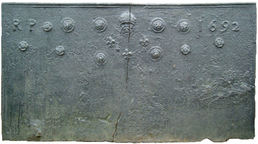-
513
Description: Rectangular; complex (astragal & fillet/cavetto) moulded edging; initials across top, between split date.
Inscription: 16 WSG 98 [‘S’ reversed]
- Decoration tags:
- rectangular (shape)
- astragal and fillet/cavetto (edging)
- individual letters
- individual numbers
- planklines
- text
Manufactured: in 1698 in the Weald area of England.
Current location: Penshurst Place, Penshurst, Kent, England.
- Attached to series:
- Date & initials firebacks
-
516
Description: Arched rectangular central panel with bead-and-pellet edging; on a ground between two plants, a gadrooned flower vase with two, scrolled handles, tulips and other flowers issuing from the narrow neck; arched rectangular border with fillet edging; mirrored descending flower swags; along a rectangular bottom panel with fillet edging a symmetrical arrangement of swirled foliage; on top, two mirrored sea serpents.
Notes: The presence of tulips suggest a Dutch origin for the pattern of this fireback, although the presence of several examples in England suggest that it was produced here rather than on the Continent.
Copies of this fireback are known.
- Decoration tags:
- 'Dutch' (shape)
- fillet (edging)
- whole carved pattern
- planklines
- pictorial
- plants
- objects
Manufactured: in the late-17th century in England.
Current location: Penshurst Place, Penshurst, Kent, England.
- Attached to series:
- Flower Vase 'Dutch' types
- British 'Dutch' style firebacks
-
575
Description: Arched rectangular shape; cavetto-moulded edging; on each side a column of small overlapping leaves above a pedestal with a single acanthus leaf; issuing from the top of each column two ribbons, in figure-of-eight with grenade terminals, fly across the arch; within an arched rectangular central panel with bead edging three naked children disport about a swag of fruit, with a central pomegranate, suspended from the top of each column; one figure sits on the top, facing right, the other two hang symmetrically from below, with mirrored swirls behind them; along the base is a line of acanthus leaves; on top a sea serpent is curled on each end.
Notes: The design may have been inspired by the paintings of Jan Pauwel Gillemans the younger (1651-1704); he may have worked in London in 1675-8. Another version of the fireback (no. 591), probably by the same pattern-maker, has a slightly different design. Mitford collection, Petworth House.
Copies of this fireback are known.
- Decoration tags:
- 'Dutch' (shape)
- cavetto (edging)
- whole carved pattern
- planklines
- pictorial
- mythological
- humans
- plants
Manufactured: in the late-17th century in England.
Current location: Petworth House, Petworth, West Sussex, England.
Museum number: PET/M/66 (part of the National Trust museum group)
- Attached to series:
- Carolean 'Dutch' series
-
520
Description: Arched rectangular central panel with bead edging; with tassel at top; three nude female figures: on top, Juno/Hera with a peacock, to the left Venus/Aphrodite, the young cupid/Eros at her feet, to the right Minerva/Athena with spear and shield; arched rectangular border with fillet edging; the heads of two putti and from them two suspended festoons of fruit and leaves; at the bottom, the inscription, THE 3 GODDESES, widely spaced. On top, two figures of Triton blowing seashells. On each shoulder of the fireback, a fluted vase with flowers issuing.
Notes: The three eponymous goddesses are those whose beauty was the subject of the Judgement of Paris. The composition is copied from an engraving by Adriaen Collaert (c1560-1618). This fireback is an instance of a continental back which has been recast in England, the opportunity being taken to insert an English inscription in place of the customary date and pattern maker's monogram. Mitford collection, Petworth House.
Copies of this fireback are known.
Inscription: THE 3 GODDESES [sic]
- Decoration tags:
- 'Dutch' (shape)
- fillet (edging)
- whole carved pattern
- planklines
- pictorial
- mythological
- text
Manufactured: in the late-17th century in England.
Current location: Petworth House, Petworth, West Sussex, England.
Museum number: NT/PET/M/74 (part of the National Trust museum group)
- Attached to series:
- 'Dutch' NDW series
- Judgement of Paris firebacks
-
539
Description: Arched rectangular central panel with bead-on-fillet edging; pictorial scene of two men in mid-17t century dress carrying a large bunch of grapes on a pole between them, above them drapery; arched rectangular border with fillet edging; cascade of flowers around arch and down sides; on top, central crown with descending serpents, an urn on each shoulder of the plate.
Notes: The scene depicts Joshua and Caleb returning from Canaan with a bunch of grapes (Numbers 13: 23-4). Mitford collection, Petworth House.
Manufactured: in the late-17th century possibly in the Siegerland area of Germany.
Current location: Petworth House, Petworth, West Sussex, England.
Museum number: NT/PET/M/94 (part of the National Trust museum group)
-
538
Description: Arched rectangular shape; fillet edging; blank arched rectangular central panel with rebated fillet edging; on top, above a cone of laurel leaves, a crown supported by two putti, each holding a plant stem; on each side, a flower and fruit festoon suspended on a ribbon from a ring; at the bottom , inscription on a scroll.
Notes: A border panel, usually incorporated with a separate pictorial central panel. Mitford collection, Petworth House.
Copies of this fireback are known.
Inscription: [...]O 1695
- Decoration tags:
- rectangular with round arch (shape)
- fillet (edging)
- carved pattern panels
- text
- humans
- plants
- objects
Manufactured: in 1695 in the Siegerland area of Germany.
Current location: Petworth House, Petworth, Kent, England.
Museum number: NT/PET/M/93 (part of the National Trust museum group)
- Attached to series:
- 'Dutch' Border only firebacks
- 'Dutch' 1695 Crown series
-
593
Description: Rectangular, cavetto moulded edging; Stuart royal shield, garter, supporters and crown.
Notes: Four clear vertical plank lines indicate that the pattern for this fireback was formed of a series of boards probably secured by horizontal battens on the rear.
Copies of this fireback are known.
Inscription: HONI SOIT QVI MAL Y PENSE
Arms: English Stuart royal
- Decoration tags:
- rectangular (shape)
- cavetto (edging)
- whole carved pattern
- planklines
- armorial
- royal
- text
Manufactured: in the late-17th century in England.
Current location: Ham House, Richmond, Surrey, England.
Museum number: 1140118 (part of the National Trust museum group)
- Attached to series:
- Stuart royal armorial firebacks
-
1096
Description: Rectangular shape; ogee/cyma reversa moulded edging (top and sides); top centre, shield-shaped stamp bearing initials above date.
Notes: Two blemishes on the surface of the casting indicate that the molten iron was probably poured from two ladles simultaneously disturbing the casting sand in both locations.
Inscription: AE / 1698
- Decoration tags:
- rectangular (shape)
- cyma reversa/ogee (edging)
- carved stamps
- date stamp
- heraldic
- text
Manufactured: in 1698 in the Weald area of England.
Current location: The Manor House, Mark Cross Lane, Ripe, East Sussex, England.
- Attached to series:
- Date & initials firebacks
-
609
Description: Rectangular with plait-effect border and a column of beads down each side; pictorial scene of a male figure in gown and full-bottom wig, holding a fool’s cap in his right hand, standing behind a seated male figure, bald and bearded, with the papal triple crown falling off his head; he is seated at a desk on which are two books; behind him and to the right, three books are on a small shelf. Above the figures, a longer shelf, the width of the plate, supports other books and papers, together with the figure of a dog, from whose mouth a scroll issues bearing an unreadable inscription. On top, two putti hold hands in front of a flaming grenade.
Notes: The design is copied from a cartoon of c.1672 showing Titus Oates, the instigator of the popish Plot, presenting a fool’s cap to the Pope (see Hodgkinson 2010, p.209).
Copies of this fireback are known.
- Decoration tags:
- rectangular with ornate arch (shape)
- bead (edging)
- whole carved pattern
- pictorial
- humans
- objects
Manufactured: in the late-17th century in England.
Current location: Mark Ripley Forge & Fireplaces, Northbridge Street, Robertsbridge, East Sussex, England.
- Attached to series:
- Miscellaneous pattern firebacks
-
611
Description: Rectangular; twisted rope edging (top and sides) with fillet inside; top centre, rose-and-crown between four concentric roundels, two on each side in line, with two more below the inner ones; small fleurs-de-lys in triad below rose-and-crown; top left, initials; top right, date; small rose below date; triad of small roses to right of, and below, initials.
Notes: The style of rose and crown is similar to that used in gun founding in the Tudor period, suggesting that the furnace that was the source of this fireback may have been previously used for that purpose. Sold at Christie's Masters and Makers auction, 30 November 2010, lot 524 (£688).
Inscription: RP 1692
- Decoration tags:
- rectangular (shape)
- rope (edging)
- carved stamps
- heraldic
- royal
- text
- objects
Manufactured: in 1692 in the Weald area of England.
Current location: in private hands, Wadhurst, East Sussex, England.
- Attached to series:
- 1660s-90s Wealden series
- Fleur-de-lys firebacks

